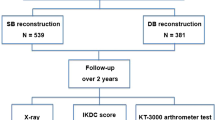Abstract
Purpose
The purpose of this study was to examine the effect of tourniquet use on operative performance and early postoperative results of anatomic double-bundle anterior cruciate ligament (ACL) reconstruction.
Methods
Fifty-one patients who underwent scheduled ACL reconstruction for unilateral ACL deficiency from June 2010 to October 2011 were included in this study. The mean age at surgery was 26.3 years (range 14–45 years). An anatomic bundle reconstructive procedure with an autogenous hamstring tendon graft was performed in all cases. These patients were randomly divided into two groups: the tourniquet group (T group) and no tourniquet group (NT group). The reconstructive procedure was performed with the use of a tourniquet for 28 patients in the T group, while a tourniquet was inflated only during the graft harvest for 23 patients in the NT group. The surgical procedure and postoperative management were identical for both groups. Inter-group comparison was conducted for intra- and peri-operative clinical parameters as well as early postoperative results (functional recovery at 3 months).
Results
The arthroscopic visual field during the procedure was not compromised even without the use of a tourniquet. There was no significant difference in operative time between the groups (P = 0.10). The amount of blood corrected through the intraarticular drain was significantly larger in the T group (P = 0.02), while total blood loss calculated by the postoperative reduction of the hemoglobin value was not significantly different between the groups (P = 0.74). Although the VAS value for postoperative numbness was significantly higher in the T group (P = 0.0002), the VAS value for pain was not significantly different (P = 0.30). Additionally, recovery of muscle strength at 3 months was not significantly different between the groups.
Conclusion
This comparative study showed that arthroscopic procedures could be uneventfully performed without the use of a tourniquet. The clinical parameters when not using a tourniquet were not significantly different, but the use of a tourniquet resulted in an increase in postoperative intraarticular bleeding and VAS for numbness.
Level of evidence
Prospective randomized study, Level II.






Similar content being viewed by others
References
Johnson DS, Stewart H, Hirst P, Harper NJ. Is tourniquet use necessary for knee arthroscopy? Arthroscopy. 2000;16:648–51.
Pedwitz RA. Tourniquet-induced neuromuscular injury. A recent review of rabbit and clinical experiments. Acta OrthopScand Suppl. 1991;245:1–33.
Thorblad J, Ekstrand J, Hamberg P, Gillquist J. Muscle rehabilitation after arthroscopic meniscectomy with or without tourniquet control. A preliminary randomized study. Am J Sports Med. 1985;13:133–5.
Dobner JJ, Nitz AJ. Postmeniscectomy tourniquet palsy and functional sequelae. Am J Sports Med. 1982;10:211–4.
Pedowitz RA, Gershuni DH, Schmidt AH, Fridén J, Rydevik BL, Hargens AR. Muscle injury induced beneath and distal to a pneumatic tourniquet: a quantitative animal study of effects of tourniquet pressure and duration. J Hand Surg Am. 1991;16:610–21.
Hirota K, Hashimoto H, Kabara S, Tsubo T, Sato Y, Ishihara H, Matsuki A. The relationship between pneumatic tourniquet time and the amount of pulmonary emboli in patients undergoing knee arthroscopic surgeries. Anesth Analg. 2001;93:776–80.
Saunders KC, Louis DL, Weingarden SI, Waylonis GW. Effect of tourniquet time on postoperative quadriceps function. Clin Orthop Relat Res. 1979;143:194–9.
Nitz AJ, Dobner JJ, Matulionis DH. Pneumatic tourniquet application and nerve integrity: motor function and electrophysiology. Exp Neurol. 1986;94:264–79.
Daniel DM, Lumkong G, Stone ML, Pedwitz RA. Effects of tourniquet use in anterior cruciate ligament reconstruction. Arthroscopy. 1995;11:307–11.
Nicholas SJ, Tyler TF, McHugh MP, Gleim GW. The effect on leg strength of tourniquet use during anterior cruciate ligament reconstruction: a prospective randomized study. Arthroscopy. 2001;17:603–7.
Arciero RA, Scoville CR, Hayda RA, Snyder RJ. The effect of tourniquet use in anterior cruciate ligament reconstruction. A prospective, randomized study. Am J Sports Med. 1996;24:758–64.
Rorabeck CH, Kennedy JC. Tourniquet-induced nerve ischemia complicating knee ligament surgery. Am J Sports Med. 1980;8:98–102.
Gutin B, Warren R, Wickiewicz T, O’Brien S, Altchek D, Kroll M. Does tourniquet use during anterior cruciate ligament surgery interfere with postsurgical recovery of function? A review of the literature. Arthroscopy. 1991;7:52–6.
Shino K, Suzuki T, Iwahashi T, Mae T, Nakamura N, Nakata K, Nakagawa S. The resident’s ridge as an arthroscopic landmark for anatomical femoral tunnel drilling in ACL reconstruction. Knee Surg Sports Traumatol Arthrosc. 2010;18:1164–8.
Purnell ML, Larson AI, Clancy W. Anterior cruciate ligament insertions on the tibia and femur and their relationships to critical bony landmarks using high-resolution volume-rendering computed tomography. Am J Sports Med. 2008;36:2083–90.
Zantop T, Diermann N, Schumacher T, Schanz S, Fu FH, Petersen W. Anatomical and nonanatomical double-bundle anterior cruciate ligament reconstruction: importance of femoral tunnel location on knee kinematics. Am J Sports Med. 2008;36:678–85.
Dang AB, McCarthy MB, Dang AB, Chowaniec DM, Mazzocca AD. Effects of adding epinephrine to arthroscopic irrigation fluid on cultured chondrocyte survival in vitro. Arthroscopy. 2011;27:1118–22.
Acknowledgments
The authors would like to thank Mr. Devin Casadey for his assistance in the preparation of the article.
Conflict of interest
The authors declare that they have no conflicts of interest.
Author information
Authors and Affiliations
Corresponding author
About this article
Cite this article
Nakayama, H., Yoshiya, S. The effect of tourniquet use on operative performance and early postoperative results of anatomic double-bundle anterior cruciate ligament reconstruction. J Orthop Sci 18, 586–591 (2013). https://doi.org/10.1007/s00776-013-0405-2
Received:
Accepted:
Published:
Issue Date:
DOI: https://doi.org/10.1007/s00776-013-0405-2



